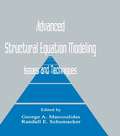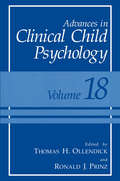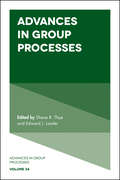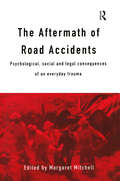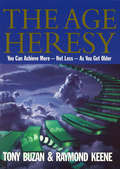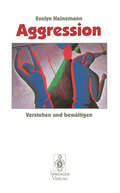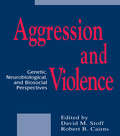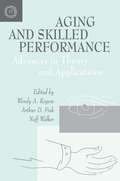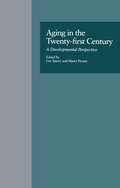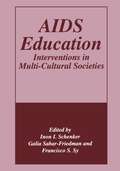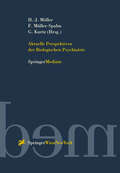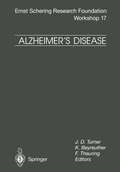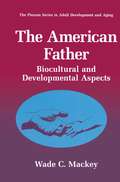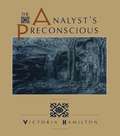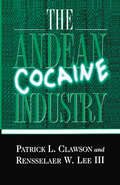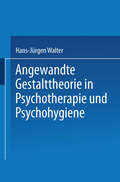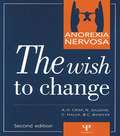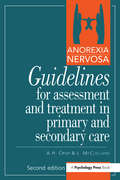- Table View
- List View
Advanced Structural Equation Modeling: Issues and Techniques
by George A. Marcoulides Randall E. SchumackerBy focusing primarily on the application of structural equation modeling (SEM) techniques in example cases and situations, this book provides an understanding and working knowledge of advanced SEM techniques with a minimum of mathematical derivations. The book was written for a broad audience crossing many disciplines, assumes an understanding of graduate level multivariate statistics, including an introduction to SEM.
Advances in Clinical Child Psychology: Volume 18 (Advances in Clinical Child Psychology #18)
by Ronald J. Prinz Thomas H. OllendickAs in past volumes, the current volume of Advances in Clinical Child Psychology strives for a broad range of timely topics on the study and treatment of children, adolescents, and families. Volume 18 includes a new array of contributions covering issues pertaining to treatment, etiol ogy, and psychosocial context. The first two contributions address conduct problems. Using quali tative research methods, Webster-Stratton and Spitzer take a unique look at what it is like to be a parent of a young child with conduct problems as well as what it is like to be a participant in a parent training program. Chamberlain presents research on residential and foster-care treatment for adolescents with conduct disorder. As these chapters well reflect, Webster-Stratton, Spitzer, and Chamberlain are all veterans of programmatic research on treatment of child and adolescent conduct problems. Wills and Filer describe an emerging stress-coping model that has been applied to adolescent substance use and is empirically well justi fied. This model has implications for furthering intervention strategies as well as enhancing our scientific understanding of adolescents and the development of substance abuse. Foster, Martinez, and Kulberg confront the issue that researchers face pertaining to race and ethnicity as it relates to our understanding of peer relations. This chapter addresses some of the measurement and conceptual challenges relative to assessing ethnic variables and relating these to social cognitions of peers, friendship patterns, and peer accep tance.
Advances in Group Processes (Advances in Group Processes #34)
by Shane R. Thye Edward J. LawlerAdvances in Group Processes publishes theoretical analyses, reviews and theory-based empirical chapters on group phenomena. The series adopts a broad conception of “group processes.” This includes work on groups ranging from the very small to the very large, and on classic and contemporary topics such as status, power, trust, justice, social influence, identity, decision-making, intergroup relations and social networks. Previous contributors have included scholars from diverse fields including sociology, psychology, political science, economics, business, philosophy, mathematics and organizational behavior. Volume 34 brings together papers that address theoretical and empirical issues related to the spread of status value, reward expectations theory, age and gender effects, and measuring the impact of status manipulations. Other contributions examine cognitive orientation, perspective taking and empathy, the stability of values, and group perceptions during computer-mediated communication. Overall, the volume includes papers that reflect a wide range of theoretical approaches from leading scholars who work in group processes.
Advances in Group Processes: Thirtieth Anniversary Edition (Advances in Group Processes #34)
by Shane R. Thye Edward J. LawlerAdvances in Group Processes publishes theoretical analyses, reviews and theory-based empirical chapters on group phenomena. The series adopts a broad conception of “group processes.” This includes work on groups ranging from the very small to the very large, and on classic and contemporary topics such as status, power, trust, justice, social influence, identity, decision-making, intergroup relations and social networks. Previous contributors have included scholars from diverse fields including sociology, psychology, political science, economics, business, philosophy, mathematics and organizational behavior. Volume 34 brings together papers that address theoretical and empirical issues related to the spread of status value, reward expectations theory, age and gender effects, and measuring the impact of status manipulations. Other contributions examine cognitive orientation, perspective taking and empathy, the stability of values, and group perceptions during computer-mediated communication. Overall, the volume includes papers that reflect a wide range of theoretical approaches from leading scholars who work in group processes.
The Aftermath of Road Accidents: Psychological, Social and Legal Consequences of an Everyday Trauma
by Margaret MitchellAccidents on the road are so common place in our lives today it's easy to believe that there are plenty of support systems in place for the victims. Death and injuries on the road are construed primarily as medico-legal phenomena, re-inforced both by the way accidents are described and by issues of insurance and compensation for damage and personal injury. But there are many profound psychological and social consequences that remain underestimated. Margaret Mitchell has compiled this collection from leading researchers to examine this neglected area for the unseen victims: the families who have to cope with bereavement or a disabled relative, the driver who has killed but is medically uninjured. It will be of great direct value to psychologists, psychiatrists and other health professionals and will serve as a useful reference for those in the legal profession, voluntary associations and those with personal experience of road, traffic, accidents needing advice about where to seek further help.
The Aftermath of Road Accidents: Psychological, Social and Legal Consequences of an Everyday Trauma
by Margaret MitchellAccidents on the road are so common place in our lives today it's easy to believe that there are plenty of support systems in place for the victims. Death and injuries on the road are construed primarily as medico-legal phenomena, re-inforced both by the way accidents are described and by issues of insurance and compensation for damage and personal injury. But there are many profound psychological and social consequences that remain underestimated. Margaret Mitchell has compiled this collection from leading researchers to examine this neglected area for the unseen victims: the families who have to cope with bereavement or a disabled relative, the driver who has killed but is medically uninjured. It will be of great direct value to psychologists, psychiatrists and other health professionals and will serve as a useful reference for those in the legal profession, voluntary associations and those with personal experience of road, traffic, accidents needing advice about where to seek further help.
The Age Heresy: How to Achieve More - Not Less - As You Get Older
by Buzan , Tony And Keene , RaymondIt is widely assumed that as we grow older there is a gradual decline in the way we use our brains. This book draws on acclaimed and proven scientific evidence to put forward a sensational brand-new theory which explodes the myth and shows that, with the right sort of mental and physical exercise, you can actually significantly improve your brain power as you get older. Drawing upon a wealth of fascinating facts and records, with studies of great geniuses such as Einstein and Goethe who improved with age, THE AGE HEARSY is packed with practical advice and guidance on how you can actively learn to enhance your memory, powers of creativity and concentration.
Aggression: Verstehen und bewältigen
by Evelyn HeinemannSind Menschen von Natur aus aggressiv oder wird aggressives Verhalten erst im Laufe des Lebens erlernt? Evelyn Heinemann beschreibt, wie Aggressionen entstehen, wie sich das Aggressionsverhalten von Männern und Frauen unterscheidet und wie andere Kulturen mit Aggression umgehen. Aus ihrer therapeutischen Praxis mit Gewalttätern zeigt sie, welche Wege aus der Gewalt führen.
Aggression and Violence: Genetic, Neurobiological, and Biosocial Perspectives
by David M. Stoff Robert B. CairnsConceived at a time when biological research on aggression and violence was drawn into controversy because of sociopolitical questions about its study, this volume provides an up-to-date account of recent biological studies performed -- mostly on humans. A group of scientists recognized the importance of freedom of inquiry and deemed it vital to address the most promising biological research in the field. The focus on biological mechanisms is not meant to imply that biological variables are paramount as a determinant of violence. Rather, biological variables operate in conjunction with other variables contributing to aggression or violence, and a complete understanding of this phenomenon requires consideration of all influences bearing on it. This book will familiarize readers with the rapidly growing and increasingly significant body of knowledge on the biological bases of human antisocial, aggressive, and violent behaviors. The editors concentrated on biological influences that support the basic physiological and biochemical processes of the brain and did not cover those biological influences that impact on the health of the individual such as head injury, pregnancy and birth complications, diet, and exposure to lead and other toxins. They focused on biological influences to illuminate their role in the complex behavioral phenomenon of violence. Three different approaches to the biological study of human antisocial, aggressive, and violent behaviors are represented -- genetic, neurobiological, and biosocial. Representing each of these three approaches, individual chapters from investigators in psychobiology, biological psychiatry, and basic-clinical neurosciences address the most recent experimental findings, methods, theory, and common misconceptions in the biological study of aggression and violence. The areas of primary focus are behavior and molecular genetics, neurochemistry and hormones, neuroimaging, psychophysiology and developmental psychobiology. Generally speaking, investigators following these different approaches have experience in different scientific backgrounds, select different methods, generate different analyses, employ different conceptual definitions for some of the same terms, and assume a different philosophical stance in attempting to explain violence. Nevertheless, all are united in their efforts to understand the biological underpinnings of violence. This book then assumes a comprehensive approach wherein different levels of analysis and different approaches inform each other. It is clear from the studies reported that aggression and violence are multidetermined phenomena and understanding them requires an interdisciplinary approach spanning economic, sociopolitical, psychological, sociological, and criminological as well as biomedical considerations. Nature (biology) and nurture (experience, context) are fundamentally inseparable in explaining aggression and violence; biology may affect experience or context, but experience or context also influences biology. Both need to be studied in a search for explanations of this phenomena.
Aggression and Violence: Genetic, Neurobiological, and Biosocial Perspectives
by David M. Stoff Robert B. CairnsConceived at a time when biological research on aggression and violence was drawn into controversy because of sociopolitical questions about its study, this volume provides an up-to-date account of recent biological studies performed -- mostly on humans. A group of scientists recognized the importance of freedom of inquiry and deemed it vital to address the most promising biological research in the field. The focus on biological mechanisms is not meant to imply that biological variables are paramount as a determinant of violence. Rather, biological variables operate in conjunction with other variables contributing to aggression or violence, and a complete understanding of this phenomenon requires consideration of all influences bearing on it. This book will familiarize readers with the rapidly growing and increasingly significant body of knowledge on the biological bases of human antisocial, aggressive, and violent behaviors. The editors concentrated on biological influences that support the basic physiological and biochemical processes of the brain and did not cover those biological influences that impact on the health of the individual such as head injury, pregnancy and birth complications, diet, and exposure to lead and other toxins. They focused on biological influences to illuminate their role in the complex behavioral phenomenon of violence. Three different approaches to the biological study of human antisocial, aggressive, and violent behaviors are represented -- genetic, neurobiological, and biosocial. Representing each of these three approaches, individual chapters from investigators in psychobiology, biological psychiatry, and basic-clinical neurosciences address the most recent experimental findings, methods, theory, and common misconceptions in the biological study of aggression and violence. The areas of primary focus are behavior and molecular genetics, neurochemistry and hormones, neuroimaging, psychophysiology and developmental psychobiology. Generally speaking, investigators following these different approaches have experience in different scientific backgrounds, select different methods, generate different analyses, employ different conceptual definitions for some of the same terms, and assume a different philosophical stance in attempting to explain violence. Nevertheless, all are united in their efforts to understand the biological underpinnings of violence. This book then assumes a comprehensive approach wherein different levels of analysis and different approaches inform each other. It is clear from the studies reported that aggression and violence are multidetermined phenomena and understanding them requires an interdisciplinary approach spanning economic, sociopolitical, psychological, sociological, and criminological as well as biomedical considerations. Nature (biology) and nurture (experience, context) are fundamentally inseparable in explaining aggression and violence; biology may affect experience or context, but experience or context also influences biology. Both need to be studied in a search for explanations of this phenomena.
Aging and Skilled Performance: Advances in Theory and Applications
by Wendy A. Rogers Arthur D. Fisk Neff WalkerThe term "skill" encompasses an array of topics and issues. For example, individuals are skilled in a variety of domains such as chess, typing, air traffic control, or knitting; researchers study skill in a variety of ways, including speed of acquisition, accuracy of performance, and retention over time; and there are a variety of approaches to the study of skill such as computer modeling or experimental analysis. Contributing to the understanding of whether, how, when, and why skills may decline as a function of age is the goal of this volume. This book is based on the Aging and Skill Conference sponsored by the Center for Applied Cognitive Research on Aging. The broad focus of the conference was to discuss cognitive theories underlying age-related skill acquisition, transfer, and retention and to discuss applications of these theories to such issues as age-adaptive training, compensatory strategies and devices, and utilization of new and existing technology. The contributors were asked to discuss the cognitive theory relevant to their topic, explain how the theory informs the field about aging, examine where gaps exist among general cognitive theory in this area and theories of aging, and demonstrate the practical relevance of the theory to enhancing or enabling activities of daily living--for work, home, or leisure--for older adults. This is the first book to focus exclusively on aging and skill. It covers a range of abilities, provides the theoretical basis for the current status of age-related differences in skill, and offers direct evidence of the applicability of research on proficiency to aspects of daily living. Each chapter was written either by an expert in the field of aging, or by an expert in the field of skill--many expert in both areas.
Aging and Skilled Performance: Advances in Theory and Applications
by Wendy A. Rogers Arthur D. Fisk Neff WalkerThe term "skill" encompasses an array of topics and issues. For example, individuals are skilled in a variety of domains such as chess, typing, air traffic control, or knitting; researchers study skill in a variety of ways, including speed of acquisition, accuracy of performance, and retention over time; and there are a variety of approaches to the study of skill such as computer modeling or experimental analysis. Contributing to the understanding of whether, how, when, and why skills may decline as a function of age is the goal of this volume. This book is based on the Aging and Skill Conference sponsored by the Center for Applied Cognitive Research on Aging. The broad focus of the conference was to discuss cognitive theories underlying age-related skill acquisition, transfer, and retention and to discuss applications of these theories to such issues as age-adaptive training, compensatory strategies and devices, and utilization of new and existing technology. The contributors were asked to discuss the cognitive theory relevant to their topic, explain how the theory informs the field about aging, examine where gaps exist among general cognitive theory in this area and theories of aging, and demonstrate the practical relevance of the theory to enhancing or enabling activities of daily living--for work, home, or leisure--for older adults. This is the first book to focus exclusively on aging and skill. It covers a range of abilities, provides the theoretical basis for the current status of age-related differences in skill, and offers direct evidence of the applicability of research on proficiency to aspects of daily living. Each chapter was written either by an expert in the field of aging, or by an expert in the field of skill--many expert in both areas.
Aging in the Twenty-first Century: A Developmental Perspective (Issues in Aging)
by Len Sperry Harry ProsenCovering a wide range of topics, this collection of original essays deals with the consequences and challenges of our growing aging population on society. It emphasizes aging as a developmental process while addressing the future of the practice of geropsychiatry and geriatric psychotherapy. This book serves as a valuable resource to guide clinical training, practice, and research on aging into the next century and beyond.
Aging in the Twenty-first Century: A Developmental Perspective (Issues in Aging)
by Len Sperry Harry ProsenCovering a wide range of topics, this collection of original essays deals with the consequences and challenges of our growing aging population on society. It emphasizes aging as a developmental process while addressing the future of the practice of geropsychiatry and geriatric psychotherapy. This book serves as a valuable resource to guide clinical training, practice, and research on aging into the next century and beyond.
AIDS Education: Interventions in Multi-Cultural Societies
by Inon I. Schenker, Galia Sabar-Friedman and Francisco S. SySixteen years into the AIDS epidemic, our understandings of the virus, its transmis sion, modes of controlling blood banks and testing are relatively well established. In the last decade, we have also experienced an astonishing amount ofnew social science research ena bling us to better understand concepts like risk taking, gender-related prevention, women's health, and youth psychology,just to mention a few. In almost every country in the world, efforts have been made to respond affirmatively to the challenge of stopping the further spread of HIVI AIDS. Educational interventions have ranged from re-inventing the wheel to innovative programs, using a variety of health educa tion methods. The field of evaluation research now provides us a better understanding of what works and what does not work. Issues relating to human rights, the relationship be tween the affected and the healthlmedical professional communities, and to the inequality in the delivery ofpreventive and educational services are becoming an important part ofthe de bates and discussions in the concerned societies.
Aktuelle Perspektiven der Biologischen Psychiatrie
by Hans-Jürgen Möller Franz Müller-Spahn Gabriele KurtzDas Buch umfaßt die ganze Bandbreite der neurobiologischen Ansätze bei verschiedenen psychiatrischen Erkrankungen, sowohl hinsichtlich der Ätiopathogenese als auch der Therapie. In Form von Übersichtsarbeiten und Originalpublikationen von Ergebnissen einzelner Studien wird ein sehr aktuelles und sehr weit gefächertes Spektrum der biologisch-psychiatrischen Forschung geliefert. Neben einer Vielzahl anderer Themen stehen dabei dementielle Erkrankungen, angesichts der medizinischen und gesundheitspolitischen Bedeutung und der derzeitigen Intensität von Forschungsaktivitäten, ganz besonders im Mittelpunkt.
Alzheimer’s Disease: Etiological Mechanisms and Therapeutic Possibilities (Ernst Schering Foundation Symposium Proceedings #17)
by F. Theuring K. Beyreuther J. D. TurnerAlzheimer's Disease is a progressive neurodegenerative disorder of late life with devastating consequences for the afflicted and their carers and poses one of the major challenges to medical research. Until recently, little hope of effective therapies capable of slowing the disease process or preventing its occurrence was apparent. With recent advances in the genetics and molecular biology of the disease processes and the demonstration of the involvement of multiple aetiological factors, however, real chances are now appearing for the identification of preventive drugs. In this discussion, experts from disciplines ranging from molecular genetics to the clinic provide review and novel data concerning the aetiology of AD and the establishment of drugfinding screening methods.
The American Father: Biocultural and Developmental Aspects (The Springer Series in Adult Development and Aging)
by Wade C. MackeyIn The American Father, Wade C. Mackey documents a wealth of infor mation demonstrating the vast benefits to society when its children are raised in families with fathers. The biopsychosocial approach Mackey in human employs is consistent with the current treatment of topics development. This approach-which is grounded in a variety of diverse sources-assumes that we understand little about people when we study them a bit at a time; rather, the fullness of the individual requires a fullness of examination. For example, in the cases of fathers, we note that humans do not reproduce alone; after all, we are not an asexual species. No, human reproduction and its sequelae are social, just as clearly as they are biological, and involve the whole panoply of psychic function (mo tivation, sociability, intelligence, and the like). The evidence marshaled by Mackey indicates strongly that indi viduals and societies have an essential requirement for something more than mothering; they also need fathering. Much of the discourse and publication on fathers during the past several decades has been posited on a "more is better" model of male parenting in which it is seldom stated who it is better for-the father, the child, the mother, the couple, or the family. Further, much of this discussion infers that fathers are merely "Mr. Moms"; yet this is not so.
The Analyst's Preconscious
by Victoria HamiltonHow do the analyst's consciously held theoretical commitments intersect with the actual conduct of analysis? Do commitments to notions like "psychic truth" or "analytic neutrality" affect interpretive style, the willingness to acknowledge treatment mistakes, and other pragmatic preferences? Does the commitment to cerain comcepts entail commitment to related ideas and practices to the exclusion of others? This is the uncharted domain that Victoria Hamilton explores in The Analyst's Preconscious. At the heart of her endeavor is an imaginatively conceived empirical investigation revolving around in-depth interviews with 65 leading analysts in the United States and Britain. In these lively and free-ranging discussions, the reader encounter firsthand the thoughtfulness with which practitioners wrestle with the ambiguous relations between various theoretical positions, whether or not their own, and the exigencies of the therapeutic encounter. The result is a uniquely detailed map of contemporary psychoanalysis. Hamilton documents the existence of different analytic cultures, each shaped by a need to maintain inner consistency among fundamental assumptions and also by extratheoretical factors, including geography, collegial experiences, and exposure to particular teachers and supervisors. A major contribution to understanding the pluralism of contemporary psychoanalysis, The Analyst's Preconscious is also a celebration of the dedication and sensitivity with which contemporary analysts seek to organize their therapeutic practices amidst the welter of proliferating concepts and rival schools of thought. Coming at a critical juncture in the history of the field, this work is indispensable to all who care about psychoanalytic culture and psychoanalytic practice, and especially about the analyst's real-world adaptation to the theoretical turbulence of our time.
The Analyst's Preconscious
by Victoria HamiltonHow do the analyst's consciously held theoretical commitments intersect with the actual conduct of analysis? Do commitments to notions like "psychic truth" or "analytic neutrality" affect interpretive style, the willingness to acknowledge treatment mistakes, and other pragmatic preferences? Does the commitment to cerain comcepts entail commitment to related ideas and practices to the exclusion of others? This is the uncharted domain that Victoria Hamilton explores in The Analyst's Preconscious. At the heart of her endeavor is an imaginatively conceived empirical investigation revolving around in-depth interviews with 65 leading analysts in the United States and Britain. In these lively and free-ranging discussions, the reader encounter firsthand the thoughtfulness with which practitioners wrestle with the ambiguous relations between various theoretical positions, whether or not their own, and the exigencies of the therapeutic encounter. The result is a uniquely detailed map of contemporary psychoanalysis. Hamilton documents the existence of different analytic cultures, each shaped by a need to maintain inner consistency among fundamental assumptions and also by extratheoretical factors, including geography, collegial experiences, and exposure to particular teachers and supervisors. A major contribution to understanding the pluralism of contemporary psychoanalysis, The Analyst's Preconscious is also a celebration of the dedication and sensitivity with which contemporary analysts seek to organize their therapeutic practices amidst the welter of proliferating concepts and rival schools of thought. Coming at a critical juncture in the history of the field, this work is indispensable to all who care about psychoanalytic culture and psychoanalytic practice, and especially about the analyst's real-world adaptation to the theoretical turbulence of our time.
The Andean Cocaine Industry
by P. Clawson R. LeeIt is commonly known that the Andean nations of Colombia, Peru, and Bolivia are the international centers of cocaine production. But until now, there has been no comprehensive view of this billion dollar industry. Using never-before unearthed information culled from their extensive field research, Patrick Clawson and Rensselaer Lee reveal the configuration of the drug industry, from the original cultivation of coca in the fields of South America to the sale of cocaine on the streets of the United States. The authors analyze the economic and political impact of the drug business on the Andean nations, including such problems as violence and the undermining of legitimate business. Through the ground-breaking work of Clawson and Lee, The Andean Cocaine Industry illuminates one of the most pervasive problems facing the world today.
Angewandte Gestalttheorie in Psychotherapie und Psychohygiene
by Hans-Jürgen WalterHans-Jürgen Walter belegt in seinen Arbeiten zu Psychotherapie und Soziotherapie, Sozialarbeit und Sozialpädagogik, Organisationsentwicklung und Politik die theoretische Fruchtbarkeit und Praxisrelevanz der Gestalttheorie der Berliner Schule für verschiedene Arbeitsfelder, in denen Menschen in psychotherapeutischer, erzieherischer und politischer Absicht aufeinander einwirken. Das inzwischen modern gewordene Integrationsparadigma ist in diesen Arbeiten aus den letzten zwanzig Jahren ohne Zugeständnisse an einen seichten Eklektizismus konsistent verwirklicht. Dabei zeigt Walter die selten anzutreffende Begabung, auf verschiedenen Anwendungsgebieten Gedanken von höchster theoretischer Subtilität in produktiver und verständlicher Weise in konkrete praktische Forderungen umzusetzen.
Anorexia Nervosa: The Wish to Change
by Professor A. Crisp Neil Joughin Christine Halek Carol BowyerThis guide to 'self-help' has become highly valued by sufferers from anorexia nervosa, their families and their carers. It relates to Arthur Crisp's much praised text Anorexia Nervosa: Let Me Be, now in its third reprint. Many sufferers report that Anorexia Nervosa: The Wish to Change has provided them with their first private opportunity to reconsider their position and future properly, and then to do more about them. Carers have found it particularly helpful as a joint tool in their work with patients, especially when used alongside the more recently published Anorexia Nervosa: Guidelines for Assessment and Treatment in Primary and Secondary Care and the Patient's Log Book from the same centre.
Anorexia Nervosa: The Wish to Change
by Professor A. Crisp Neil Joughin Christine Halek Carol BowyerThis guide to 'self-help' has become highly valued by sufferers from anorexia nervosa, their families and their carers. It relates to Arthur Crisp's much praised text Anorexia Nervosa: Let Me Be, now in its third reprint. Many sufferers report that Anorexia Nervosa: The Wish to Change has provided them with their first private opportunity to reconsider their position and future properly, and then to do more about them. Carers have found it particularly helpful as a joint tool in their work with patients, especially when used alongside the more recently published Anorexia Nervosa: Guidelines for Assessment and Treatment in Primary and Secondary Care and the Patient's Log Book from the same centre.
Anorexia Nervosa: Guidelines For Assessment & Treatment In Primary & Secondary Care
by A.H. CrispWe are delighted to publish this second edition of Anorexia Nervosa: Guidelines for Assessment and Treatment in Primary and Secondary Care, based on the first author's long-standing "St George's" Approach, which has been so well received since it was first published in 1994. The book aims to outline in a clear, practical way, the minimal intervention necessary within primary and secondary care settings if the psychopathology of this serious and life-threatening illness is first to be identified and then treated with some hope of success. This first attempt at a time-limited and basic meaningful intervention involves concurrent use by both patient and therapist (and also, to some extent, the family) of the 'self-help' book Anorexia Nervosa: The Wish to Change and the Patient's Log Book, and all three books can be purchased as a package.
